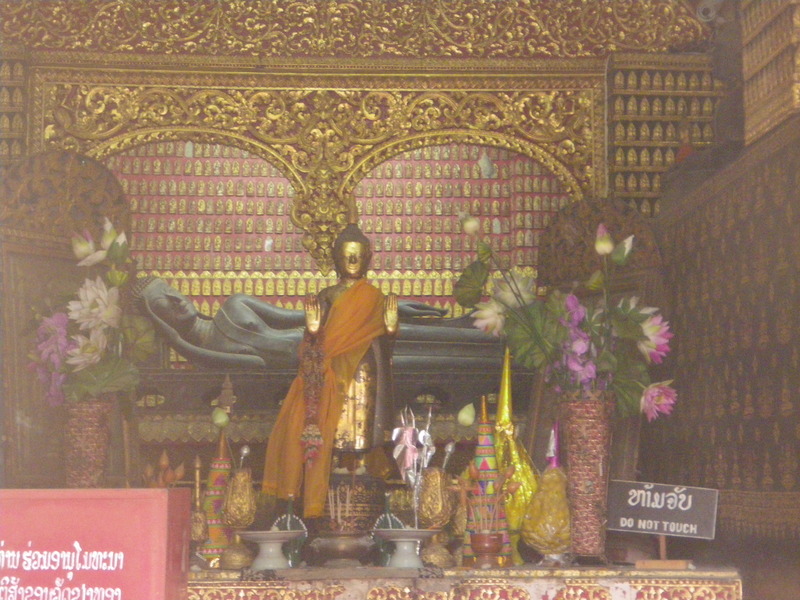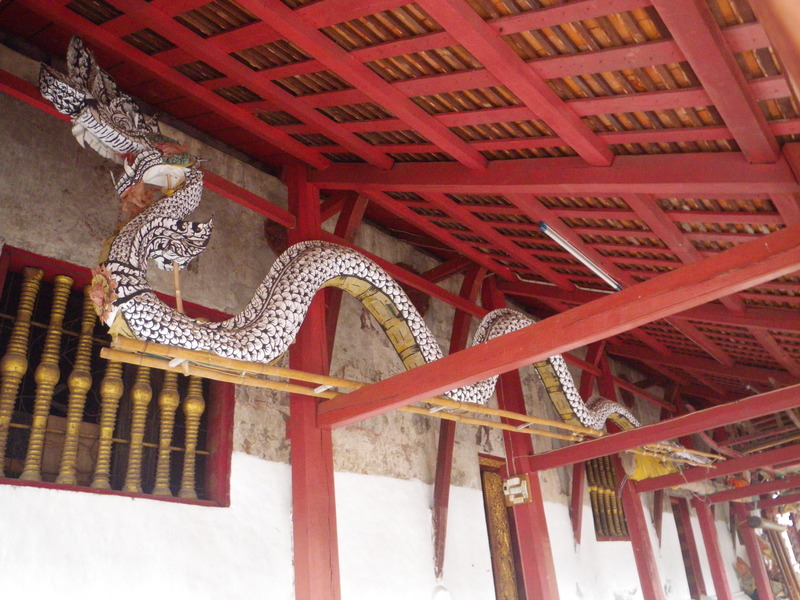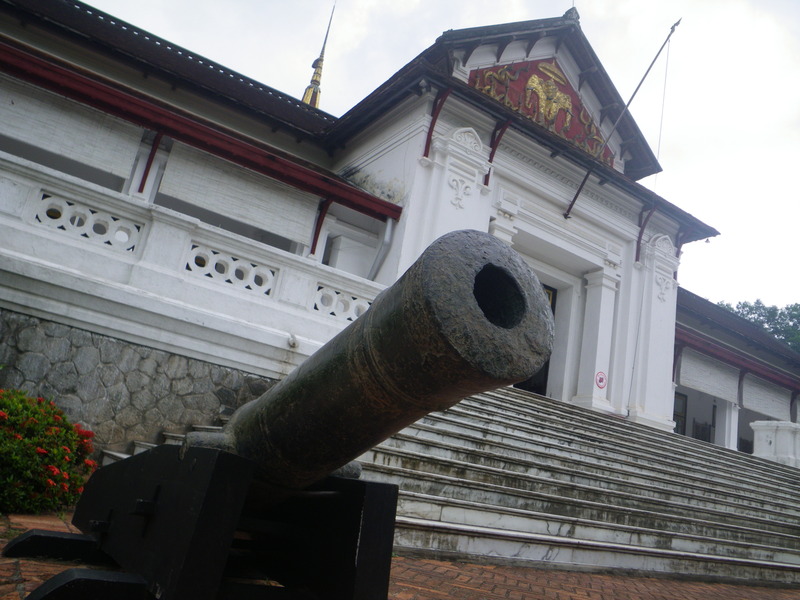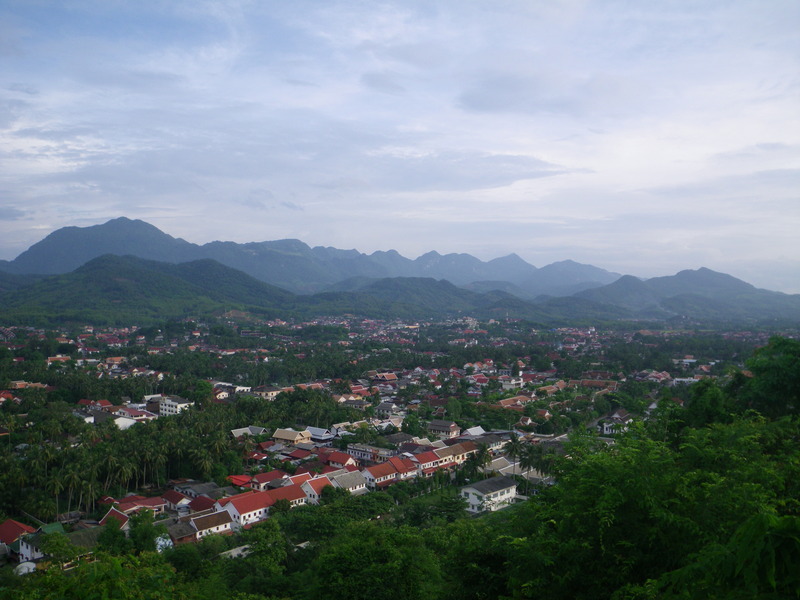
After leaving the Golden Triangle, where the borders of Thailand, Myanmar, and Laos come together, the Mekong river flows South-East into Laos, then South again. Eventually it joins the Nam Khan river which flows Southwest, then briefly West towards the Mekong.
However, the Nam Khan river cannot flow directly west to the Mekong, as there is a hill in its way, Phu Si (Phou Si). Instead, Nam Khan flows North, then West again once it has rounded the hill. With this, the Nam Khan river has carved a long narrow peninsula, with Phu Si at its base, Nam Khan on two sides, and the Mekong on the remaining side. It is an ideal, very defensible place, and it has been a city for over a thousand years. Most of this time it has been a royal capital.
The kingdoms were typically small, and Luang Prabang is not a big city. Even now it only has about 50,000 inhabitants.
Luang Prabang is easy to visit by bicycle, and my hotel very kindly provides free bicycles for its guests. To get to the old town, I get to cross an old iron bridge paved with wooden boards.

The bridge is closed to cars, but open to motorcycles, bicycles, and pedestrians. The pedestrians get to go on the outside, where the boards don't often seem to be as solid as one might wish.

The old city of Luang Prabang is a charming mix of French colonial architecture and old Wat (Buddhist temples).


The town is very quiet and relaxed, and in this way, does not resemble a stereotypical South-East Asian city. The biggest annoyance are the drivers of the 3-wheeled passenger vehicles, universally known as "tuk-tuk" (there is one in the previous picture), who always seem to find it necessary to ask if you need a ride.
Some of the wat are very beautiful.



Luang Prabang has been declared by Unesco to be a world heritage site, and there are several signs around the city announcing joint Lao and French financial support for various projects. Without such support, the various wat would probably be in poor shape. For example, the building in the next picture probably has not been maintained recently. This is a rare exception -- most of the city is beautifully maintained.

One of the most beautiful temples is Vat Xieng Toung (written the French way -- "Wat Cheng Toeng" might be a more English romanization). Several of the buildings there are painted in a generally pink/purple color and have beautiful glass mosaic decorations.



Inside one of the buildings is a sleeping Buddha who looks very peaceful.

And outside another of the buildings is a drawing of the Bo tree (Bodhi tree) under which the Buddha was meditating when he found enlightenment.

But there are many interesting things to see. One recurring motif is that of the Naga, a mythical serpent whose home is the Mekong river. Sometimes Naga has multiple heads, as in this wheeled vehicle.

Whereas in this other wheeled vehicle, from the royal palace, each Naga only has one head.

Sometimes Naga is shown devouring another creature, usually somewhat resembling the Naga itself, but perhaps intended to be a crocodile (it often has small legs).


And sometimes, as in this picture from Vatmay Souvannapoumaram, a temple near the royal palace, Naga is made of paper and clearly meant to be carried around during a procession.

But most often, Naga is simply used as a decoration for the entrances of temples.


This lucky crocodile has, so far, escaped Naga.

Another very common feature in the Wat and other old buildings is carved wood covered in gold leaf.






Being a royal capital, Luang Prabang of course has a royal palace. The communist revolution, finally successful in 1975 and resulting in the death of the king, ended the monarchy, so the former royal palace is now a museum. As usual, no pictures are allowed inside the museum, but the entrance itself is quite nice.



The former royal palace is still the home of Prabang, a very revered Buddha statue. The statue was brought to the city in the 1300s, a gift from a Khmer king, and has given Luang Prabang itself its name (the city had other names before).
I have also made it to the top of Phu Si, the hill that turned aside the Nam Khan river and made this such a great place for a capital. Phu Si is very green, and has a little temple at the top.

There are a few too many steps for me to count all the way to the top, but I would estimate around 300 steps. The entrance fee for going to the summit is 20,000 Kip per person, which works out to about $2.50. If you're good at math, that's about 8,000 Kip to the US$.
Reaching the top is of course rather satisfactory, and not just because of the temples.


The views of Luang Prabang are beautiful, with green mountains all around.



In the previous picture, you can see an iron and wooden bridge across the Nam Khan river. Just to the left, on the river, is the "Le Bel Aire" hotel, where I am staying.
The views of the Mekong river and the sunset are equally beautiful.




